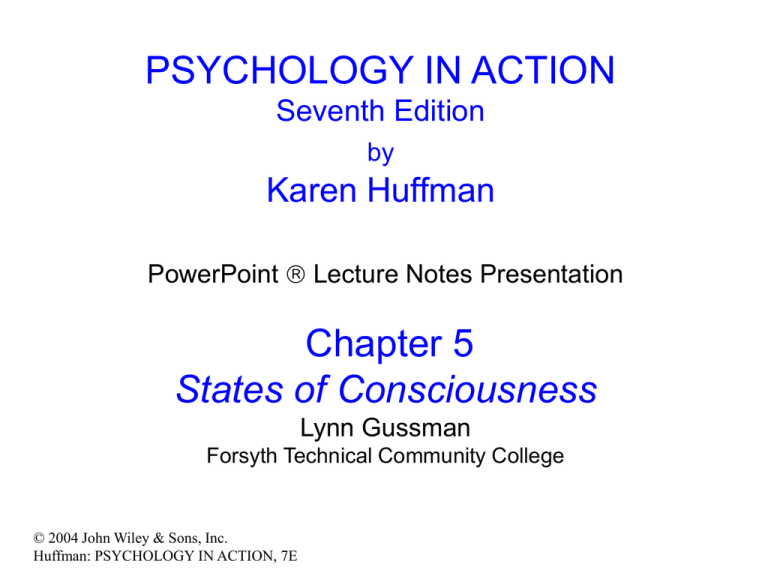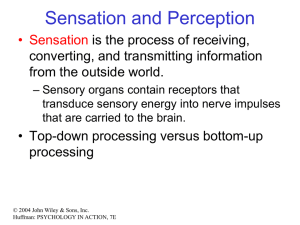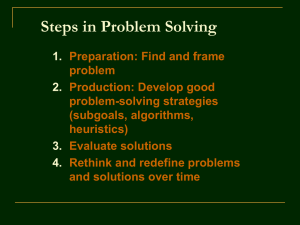
PSYCHOLOGY IN ACTION
Seventh Edition
by
Karen Huffman
PowerPoint Lecture Notes Presentation
Chapter 5
States of Consciousness
Lynn Gussman
Forsyth Technical Community College
© 2004 John Wiley & Sons, Inc.
Huffman: PSYCHOLOGY IN ACTION, 7E
Note to the Instructor
• The following set of slides provides a basic
foundation for your PowerPoint presentation
of the core concepts found in Chapter 5 of
Psychology in Action (7e).
• Please consult our website:
http://www.wiley.com/college/huffman or the
Instructor's Resource CD for additional
options, including video clips, figures, tables,
key terms, etc.
© 2004 John Wiley & Sons, Inc.
Huffman: PSYCHOLOGY IN ACTION, 7E
Lecture Overview
•
•
•
•
Issues in Consciousness
Sleep and Dreams
Drugs that Influence Consciousness
Alternate States of Consciousness
© 2004 John Wiley & Sons, Inc.
Huffman: PSYCHOLOGY IN ACTION, 7E
Consciousness
• Consciousness refers to an organism’s
awareness of itself and its surroundings.
• Levels of awareness:
– TOP: Controlled processes require attention
(and interfere with other functions)
– MIDDLE: Automatic processes require minimal
attention (such as riding your bike)
– LOWEST: Minimal or no awareness of the
environment
© 2004 John Wiley & Sons, Inc.
Huffman: PSYCHOLOGY IN ACTION, 7E
Circadian Rhythms
• Many of our behaviors display rhythmic
variation.
– Circadian rhythms
• One cycle lasts about 24 hours (e.g. sleepwaking cycle).
• Light is an external cue that can set the
circadian rhythm.
• Some circadian rhythms are endogenous
suggesting the existence of an internal
(biological) clock.
© 2004 John Wiley & Sons, Inc.
Huffman: PSYCHOLOGY IN ACTION, 7E
Sleep
• Sleep is a behavior AND an altered state of
consciousness.
• We spend about a third of our lives in
sleep.
– A basic issue is to understand the function of
sleep.
© 2004 John Wiley & Sons, Inc.
Huffman: PSYCHOLOGY IN ACTION, 7E
Myths of Sleep
• Everyone needs 8 hrs of sleep per night to
maintain good health.
• Learning of complicated subjects such as
calculus can be done during sleep.
• Some people never dream.
• Dreams last only a few seconds.
• Genital arousal during sleep reflects dream
content.
• May be a useful index of physical versus
psychological causes of impotence in males
© 2004 John Wiley & Sons, Inc.
Huffman: PSYCHOLOGY IN ACTION, 7E
EEG Changes During Sleep
• Electrophysiological
instruments can be used in
the sleep laboratory to assess
the physiological changes that
occur during an episode of
sleep.
© 2004 John Wiley & Sons, Inc.
Huffman: PSYCHOLOGY IN ACTION, 7E
Stages of Sleep
• Hypnagogic state: “pre-sleep” stage marked by
visual, auditory and kinesthetic sensations.
• Non-REM
Stage one
Stage two
Stage three
Stage four
• REM: rapid eyes movements, high frequency
brain waves, paralysis of large muscles and
dreaming
© 2004 John Wiley & Sons, Inc.
Huffman: PSYCHOLOGY IN ACTION, 7E
Sleep Stages During a Night
© 2004 John Wiley & Sons, Inc.
Huffman: PSYCHOLOGY IN ACTION, 7E
Functions of Sleep
• REM Sleep:
– Consolidation of new memories
– Role in learning
– Absent in lower mammals
• Non-REM sleep
– People deprived of all sleep show greater
time spent in non-REM sleep the next
night.
© 2004 John Wiley & Sons, Inc.
Huffman: PSYCHOLOGY IN ACTION, 7E
Effects of Sleep Deprivation
•
•
•
•
•
•
Reduced immunity
Mood alteration
Reduced concentration and motivation
Increased irritability
Lapses in attention
Reduced motor skills
© 2004 John Wiley & Sons, Inc.
Huffman: PSYCHOLOGY IN ACTION, 7E
Theories of Sleep
• Repair/Restoration
– Sleep allows for recuperation from
physical, emotional, and intellectual
fatigue.
• Evolutionary/Circadian
– Sleep evolved to conserve energy and
protect our ancestors from predators.
© 2004 John Wiley & Sons, Inc.
Huffman: PSYCHOLOGY IN ACTION, 7E
Sleep Duration in Mammals
© 2004 John Wiley & Sons, Inc.
Huffman: PSYCHOLOGY IN ACTION, 7E
Theories of Dreaming
• Psychoanalytic: Dreams represent
disguised symbols of repressed desires
and anxieties.
– Manifest versus latent content
• Biological: Dreams represent random
activation of brain cells during sleep.
• Cognitive: Dreams help to sift and sort
the events of the day.
© 2004 John Wiley & Sons, Inc.
Huffman: PSYCHOLOGY IN ACTION, 7E
Dysomnias
• Insomnia refers to a difficulty in getting to sleep or
remaining asleep and has many causes.
– Situational: related to anxiety
– Drug-induced: Use of sleeping pills or other drugs can
result in insomnia
Sleep apnea: person stops breathing and is
awakened when blood levels of carbon dioxide
stimulate breathing.
• Narcolepsy: Sleep appears at odd times.
•
– Sleep attack: urge to sleep during the day
© 2004 John Wiley & Sons, Inc.
Huffman: PSYCHOLOGY IN ACTION, 7E
Parasomnias
• Nightmares: Anxiety-arousing dreams
generally occurring during REM sleep.
• Night Terrors: Abrupt awakenings from
NREM sleep accompanied by intense
physiological arousal and feelings of
panic.
© 2004 John Wiley & Sons, Inc.
Huffman: PSYCHOLOGY IN ACTION, 7E
Drugs
• Drugs are chemicals that have biological
effects within the body.
• Psychoactive drugs are chemicals that
change conscious awareness or
perception.
– Depressants slow down the nervous system.
– Stimulants speed up the nervous system.
– Opiates relieve pain.
– Hallucinogens alter sensory perception .
© 2004 John Wiley & Sons, Inc.
Huffman: PSYCHOLOGY IN ACTION, 7E
Drug Use and Abuse
• Drug abuse: Drug use that causes emotional
or physical harm to the user.
• Addiction results from repeated drug use.
– Tolerance: more drug is required.
– Drug abstinence leads to withdrawal symptoms.
• Drug dependence can be:
– Physical: withdrawal reactions are noted when drug
use is terminated.
– Psychological: associated with a craving for the
drug
© 2004 John Wiley & Sons, Inc.
Huffman: PSYCHOLOGY IN ACTION, 7E
Examples of Drug Types
• Depressants:
alcohol, barbiturates
• Stimulants:
caffeine, amphetamine
cocaine, nicotine
• Opiates
heroin, morphine
• Hallucinogens
LSD, mescaline, marijuana
© 2004 John Wiley & Sons, Inc.
Huffman: PSYCHOLOGY IN ACTION, 7E
Depressants
• Alcohol is particularly dangerous when
combined with barbiturates.
– abuse can lead to serious losses in
cognitive functioning
– involved in nearly half of all murders,
suicides, spousal abuse and accidental
deaths in the united states
– is the third leading cause of birth defects
© 2004 John Wiley & Sons, Inc.
Huffman: PSYCHOLOGY IN ACTION, 7E
Stimulants
• Nicotine is considered the single most
preventable cause of death and disease
in the United Sates.
• Cocaine causes physical damage,
severe addiction and psychological
dependence.
– Cocaine can interfere with the electrical
activity of the heart.
© 2004 John Wiley & Sons, Inc.
Huffman: PSYCHOLOGY IN ACTION, 7E
Opiates
• Narcotics, such as morphine and
heroin, produce their effects by
mimicking endorphins.
© 2004 John Wiley & Sons, Inc.
Huffman: PSYCHOLOGY IN ACTION, 7E
Hallucinogens
• LSD- associated with “bad trips”
• Marijuana has some properties of
depressants, narcotics and
hallucinogens at higher doses.
© 2004 John Wiley & Sons, Inc.
Huffman: PSYCHOLOGY IN ACTION, 7E
“Club Drugs”
• MDMA- high doses can cause
dangerous increases in body
temperature and blood pressure leading
to seizures, heart attacks and strokes;
can produces long lasting damage to
the brain.
© 2004 John Wiley & Sons, Inc.
Huffman: PSYCHOLOGY IN ACTION, 7E
How Drugs Work
© 2004 John Wiley & Sons, Inc.
Huffman: PSYCHOLOGY IN ACTION, 7E
Drug Action on Neurons
© 2004 John Wiley & Sons, Inc.
Huffman: PSYCHOLOGY IN ACTION, 7E
Factors that Lead to Drug
Abuse
• Positive associations: the drug is portrayed in
a positive fashion in the media.
• Biological factors: the drug induces a
pleasurable state (usually related to
dopamine activity in the brain).
• Prevention of withdrawal: person continues to
take the drug to avoid withdrawal effects.
• Conditioning of drug craving: cues associated
with drug use can elicit craving for the drug.
© 2004 John Wiley & Sons, Inc.
Huffman: PSYCHOLOGY IN ACTION, 7E
Hypnosis
• Hypnosis is an altered state of
heightened suggestibility.
• The hypnotic state is characterized by:
– Narrow and focused attention
– Imagination
– Passive receptive attitude
– Reduced reaction to pain
– Heightened suggestibility
© 2004 John Wiley & Sons, Inc.
Huffman: PSYCHOLOGY IN ACTION, 7E
Myths of Hypnosis
• People can be hypnotized against their
will.
• People will do immoral things while
hypnotized.
• Hypnosis improves memory recall.
• Hypnotized persons have special
strength.
• Hypnosis is fake.
© 2004 John Wiley & Sons, Inc.
Huffman: PSYCHOLOGY IN ACTION, 7E
Altered States
• Meditation refers to a set of techniques
that promote a heightened sense of
awareness.
– can involve body movements and posture,
focusing of attention on a focal point, or
control of breathing
– can induce relaxation, lower blood
pressure, and can be associated with a
sense of euphoria
© 2004 John Wiley & Sons, Inc.
Huffman: PSYCHOLOGY IN ACTION, 7E
Why do people alter
consciousness?
• Sacred rituals
• Social interactions
• Individual rewards
© 2004 John Wiley & Sons, Inc.
Huffman: PSYCHOLOGY IN ACTION, 7E
Copyright
Copyright 2004 by John Wiley & Sons, Inc., New
York, NY. All rights reserved. No part of the material
protected by this copyright may be reproduced or
utilized in any form or by any means, electronic or
mechanical, including photocopying, recording, or by
any information storage and retrieval system, without
written permission of the copyright owner.
© 2004 John Wiley & Sons, Inc.
Huffman: PSYCHOLOGY IN ACTION, 7E









